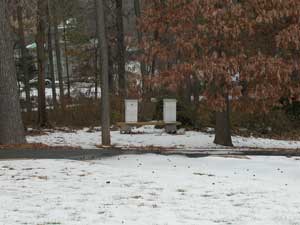 Bernd Heinrich, a famous naturalist, once spent part of a winter standing in front of beehives, trying to figure out how the honeybees knew that it was safe to fly. In a parallel of the story of Noah (who released doves to see if his particular time of stress was over, until one came back with an olive leaf), it turns out that the bees send out an emissary from time to time, as well. In the case of the bees, though, the adventurous workers fly out in singles and groups, and if the weather is wrong they do not come back. Nature sacrifices a bunch of bees, one or two at a time, in order to find Spring.
Bernd Heinrich, a famous naturalist, once spent part of a winter standing in front of beehives, trying to figure out how the honeybees knew that it was safe to fly. In a parallel of the story of Noah (who released doves to see if his particular time of stress was over, until one came back with an olive leaf), it turns out that the bees send out an emissary from time to time, as well. In the case of the bees, though, the adventurous workers fly out in singles and groups, and if the weather is wrong they do not come back. Nature sacrifices a bunch of bees, one or two at a time, in order to find Spring. Nature also sacrifices entire colonies, which is what has happened at the Mill. Today was check-on-bee-feed day, and MaryEllen helped me out by checking out the bees out in the 'burbs. Hers are not doing well, and mine are dead, or so I learned on the phone. She was terribly sorry to tell me, and is not sure what happened, other than a population crash. She says that the cluster of bees is still there, inside the boxes, and that there is still lots of honey in there, but that they are all dead (oh what a beautiful, fantastic Queen to go so young). I know they were there two weeks ago, before this cold snap, but I also know that there were probably ten thousand mites by now, too. And now all are dead, a result of a would-be symbiotic relationship (between mite and bee) gone terribly wrong. Or so I think. The hive is now sealed, and after a bit more melting, we will go in to learn more.
You cannot be a beekeeper without losing a hive, or so I am told, and have repeated to myself a bunch. The state beekeepers meeting last weekend included a talk by a government apiary inspector, who estimates that 40-60% of the hives around here will die this winter (see, I wasn't just whining all these months!)
Oh man, I feel bad. So bad I am not even working out how much. It's not the money for equipment, the hours spent to-and-from, or even those spent sweating in a bee suit several times in the August heat, spraying sucrocide on 80,000 bees (every box, every frame, both sides, in the sun, three times). Or kneeling at the hive entrance in November, attempting a last-ditch application of oxalic acid. It's how little I can help, how little I know. It is, as well, the part that I do know, which is that Nature places its bets across most possibilities (in cold and hot weather, in rain and drought), but that I made the gamble to put those bees in that apiary at that time, in my care. And they needed me to do it, and I surely wanted to, but it did not work.
The picture above is of the monastery bees, which are still alive, a picture I took while making my own rounds. They look so resolute-yet-vulnerable, there at the edge of the woods. None of the colonies are truly out of the woods, you know, and if you have any pull with the authorities, I hope you will put in a good word for the girls.
3 comments:
Just sending sympathy. I discovered two days ago that I've lost a hive and I am devastated. They were fine a week ago and then this cold snap...must have done them in. I really do know how it feels and suggest some chocolate and maybe a Guinness...I'm going in tomorrow to take the hive apart, clean out burr comb and count the dead. Yuck.
Even some times there's allot of honey in the hive, the place of it is not the right one. I mean that the cluster needs the honey to be close to it, preferably above it, as the cluster never moves left or right to find the honey reserves. An indication of that is that you see dead bees inside the cells. I always use during winter time a home made candy on top of the frames, I have no winter losses at all, although I use open bottom hives.
Oh man, I'm SO sorry to hear of your loss! But please don't beat yourself up -- last I checked you're not able to personally prevent cold snaps and this one has been a doozy. Keep on keeping!
Post a Comment